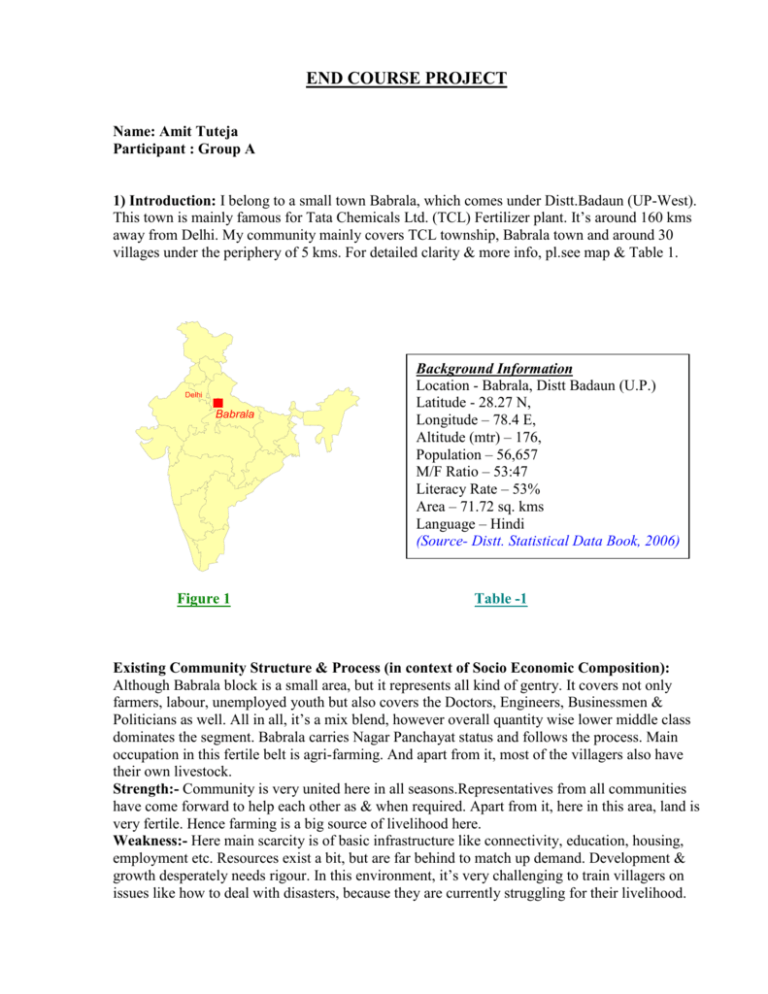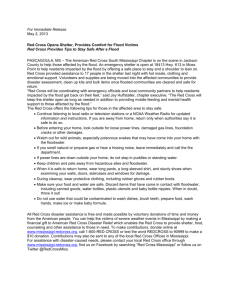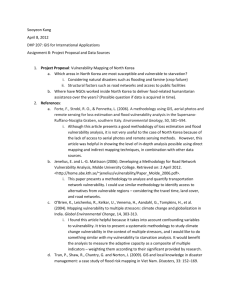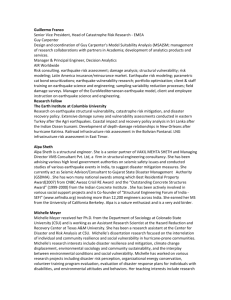END COURSE PROJECT
advertisement

END COURSE PROJECT Name: Amit Tuteja Participant : Group A 1) Introduction: I belong to a small town Babrala, which comes under Distt.Badaun (UP-West). This town is mainly famous for Tata Chemicals Ltd. (TCL) Fertilizer plant. It’s around 160 kms away from Delhi. My community mainly covers TCL township, Babrala town and around 30 villages under the periphery of 5 kms. For detailed clarity & more info, pl.see map & Table 1. Delhi Babrala Figure 1 Background Information Location - Babrala, Distt Badaun (U.P.) Latitude - 28.27 N, Longitude – 78.4 E, Altitude (mtr) – 176, Population – 56,657 M/F Ratio – 53:47 Literacy Rate – 53% Area – 71.72 sq. kms Language – Hindi (Source- Distt. Statistical Data Book, 2006) Table -1 Existing Community Structure & Process (in context of Socio Economic Composition): Although Babrala block is a small area, but it represents all kind of gentry. It covers not only farmers, labour, unemployed youth but also covers the Doctors, Engineers, Businessmen & Politicians as well. All in all, it’s a mix blend, however overall quantity wise lower middle class dominates the segment. Babrala carries Nagar Panchayat status and follows the process. Main occupation in this fertile belt is agri-farming. And apart from it, most of the villagers also have their own livestock. Strength:- Community is very united here in all seasons.Representatives from all communities have come forward to help each other as & when required. Apart from it, here in this area, land is very fertile. Hence farming is a big source of livelihood here. Weakness:- Here main scarcity is of basic infrastructure like connectivity, education, housing, employment etc. Resources exist a bit, but are far behind to match up demand. Development & growth desperately needs rigour. In this environment, it’s very challenging to train villagers on issues like how to deal with disasters, because they are currently struggling for their livelihood. 2.(i) Hazard and vulnerability Assessment: - Babrala & surrounding community area comes under Zone IV from Earthquake vulnerability point of view. This segment is also liable to the Flood, as river Ganga crosses this area. Apart from it, few incidents have also recorded related to sudden firebreak out in this rural belt. Detailed Hazard Assessment is enclosed in Table 2A. Table 2A: Hazard Assessment Hazard Assessment 1. Hazard type Flood, Fire, Earthquake etc. 2. Warning sign Flood Excessive rainfall, inadequate drainage system. Earthquake, Fire No such mechanism available as on date. 3. Forewarning Rise in river level, Torrential rainfall related information dissemination from Emergency Flood Control Center, Narora. 4. Speed of onset Flood Moderate, Fire Mild to Extensive, Earthquake Extensive 5. Frequency Flood Once in every 10 years Earthquake Frequency of such hazard not yet measured. Fire Once in five years 6. When Flood During monsoon (June-Sept) Fire & Earthquake Anytime,anywhere 7. Duration Flood Days, Fire Hours, Earthquake Momentary 8. Extent Flood Low lying area near river Ganga & surroundings may get flooded during monsoon, due to rise in river level. Fire Rural and backward areas, mainly near forest side. Apart from it, may also hit industrial & commercial places. Earthquake Applicable to all the area under this zone. Vulnerability is the extent to which, the community is affected. Hence it’s assessment is very vital. Table 2B: Vulnerability Assessment Vulnerability Assessment 1. Hazard type Flood, Fire, Earthquake etc. 2. Elements at risk: Infrastructure River bridge at Narora, Farmland, Roads, Crops, Hospitals, Schools, Industrial compound Housing Poorly built houses mainly in rural areas Livestock, etc. Cows, Buffaloes, Oxen, Goats, Dogs etc. 3. People at risk Residing in weak structures, old age people, children, ladies, handicapped & isolated persons. 4. Location of people at risk Residing in huts near riverbank and forest side, difficult to communicate,alert & evacuate them. 2.(ii) Socio-economic factors affecting vulnerability:The social and economic factors depict the actual vulnerability of any disaster. We have taken the data of 1996 severe flood, which hit Babrala & surroundings. Details attached in Table 2C. Factors Economic Income, employment, livelihood, etc. Gender Male Female Age Groups Ethnicity Table 2C: Factors Affecting Vulnerability No. of people affected Major cause 1159 Families (4857 persons) Poverty, unemployment, illiteracy, no source of livelihood are main causes 6 9 All age group people People drowned due to deadly flood Couldn’t survive during severe flood Impact of Flood. (Most of the people evacuated to safer places, in time). Farmer Community suffered huge tangible & intangible losses. Above is the example of most probable vulnerability, in this area. Apart from it, if we consider other cases like Earthquake & Fire, then the overall vulnerability may lead to higher figures/nos. The combined effect of worst scenario may hamper economics of 4500 families, which is quite high. In order to reduce the same, we shall discuss the required assets and resources in next step. 2(iii) Assets and access to resources for reducing vulnerability:To reduce the vulnerability aspect and make the community more resilient to disasters, we have to develop our assets, in a way with which these should be easily accessible,as & when required. These assets may be tangible like land, vehicle and intangible like Psychological care & support. I have tried to cover the below mentioned aspects with assets and access addressing against each in Table 2D. Table 2D: Assets and access to resources for reducing vulnerability Aspects Assets Access to Resources Material/ Physical Land, Building, Infrastructure, Via safe standards & practices, Household items, Equipments trained DM specialists, masons Financial Social/ Organizational Micro financing, savings, funds Insurance, Via Public Private partnerships, Banks, Insurance companies,Govt Schools, Hospitals, Social aids, Via National & Int. NGOs, Govt, Relief–Rehab funds, Corporate Corporate firms, Relief agencies Motivational/ Attitudinal Self Help, Income generation, Psychological care, volunteerism Via Civil defense, SHGs & INGs, NGOs, NCC, NDRF, Taskforces 3) Design of Community Preparedness Plan i). Organizing the process and identifying/assigning the roles within your community:To organize the Community Preparedness Plan, ideally it should have 7 sequential stages, which can be executed before the occurrence of a disaster, to reduce future risks. Each stage grows out of preceding stage & leads to further action. Following are the 7 steps in this process:a) Formation of Disaster Mgt Committee b) Community Profile c) Summary of past disasters d) Community resources e) Vulnerability Profile f) Community Task Forces g) Assigning role to each group Together, sequence can build up a planning and the implementation system, which can become a powerful risk management tool. What does the community need? 1) First and foremost, safety of lives (All stakeholders) 2) Safety & security of livestock, and physical assets 3) To improve the coping capacity of community 4) Well trained DM experts, who can come at rescue 5) Fully equipped Emergency Operations Centers 6) Advance and effective communication network 7) Sound early warning mechanism and evacuation plan 8) Emergency shelter homes, especially for poor & vulnerable. 9) Well coordinated R&R efforts, adequate support from Govt & NGOs 10) Block level & Village level Disaster Mgt. plan is the need of the hour, as the Distt. Disaster Mgt Plan is a macro level umbrella, where it’s difficult to get micro details. What does community have? 1) Community have skilled persons and adequate manpower 2) Community have at least basic infrastructure in place 3) Block level Flood Information Cell is available here 4) Distt. level plan is in place, which works as a lever 5) Safe building construction standards reference started 6) People are aware of disasters (not unknown), through mock drills, programs How to combine these? 1) By preparing a community level safety plan 2) Rigorously follow the building standards & codes 3) Handouts, leaflets to be circulated in local language 4) For mobilizing mass in emergency, solid evacuation plan should be in place. 5) To empower the community in terms of role, responsibility & accountability Past data analysis & review Pt data 3. ii) Community Response Plan Early Warning dissemination Disaster Evacuation & Shelter Search & Rescue First aid & trauma counselling Relief & Recovery Damage Assessment Monitor Flow Chart The above flow chart is self-explanatory. It depicts all the key stages and activities one by one. It will act as a macro level activity planner. By following it,community can respond to any disaster. iii) Community Level Mitigation Program:Structural Measures: Safe construction, Retrofitting, Community shelters, legal framework etc. Non-Structural Measures: Access to financial resources for mitigation investments, Insurance. Involvement of various agencies:This may cover Municipalities, Corporations, Boards, Nigams , Distt.Admin, Panchayats, Block level and Village level committees as well. The list is too long. 4) Conclusion Key Challenges and Proposed Actions:Challenge 1) The biggest challenge in front of us is to generate the attention of community towards Disaster Mgt. and keep them aware of disasters & its consequences. Forget about the role and responsibility part, generally community won’t spare time, to listen to it. And that’s probably because they haven’t faced any disaster as yet, hence it’s quite difficult to rouse their interest in prevention, particularly in face of basic needs of livelihood, water, accommodation etc. Proposed action: In order to bring their attention, we can take help of PRA tools. This process is very down to earth, and gives chance to everybody to speak and present his views, afterwards the members don’t feel shy, become comfortable and ready to spare some time for benefit of society. Further Govt and NGOs should come forward to conduct the awareness workshops etc. In these programs, recent cases & live examples to be explained in order to really sensitize community. Apart from it, media help can also be taken in for advertisement via TV, Cinemas, posters etc. Challenge 2) Funding is a big challenge in a country like India, especially in its backward areas like our own Dist.Badaun of UP. Nowadays it’s a big threat, which is to be definitely addressed. Proposed action: When there is will, there are ways. Here we can take examples of Cambodia’s Community Based Disaster Mgt Plan, when it was realized that flood preparedness demands are greater than financial resources available, hence it was considered essential to train and mobilize the local communities to seek funding outside. Other examples are Mexico, USA, Honduras etc. In Mexico, there are separate funds for Self Insurance,which are approved by Treasury Ministry. Our country can also adopt good practices from outside, & can plan for Social funds, Credits etc. Challenge 3) Lack of facilities, inadequate equipments and infrastructure, less scientific advancements may lead to limit/block the efforts. For Ex: In Early Warning, some work has been done, more yet to be done. In GIS/ RS, Dispersion modeling work is in progress. These elements are of no use, and won’t serve the purpose, if not implemented properly. Proposed action: In order to match with the pace of time, we have to keep updated all the time.. In existing scenario, the best way is to keep practicing with whatever available to us presently. Like, to conduct and participate in Mock drills. And afterwards improve upon their grey areas. Hazard & Vulnerability Analysis also help us in extracting data for Detailed Risk Assessment. Disaster has no particular face & schedule,it can come at any time,in any form.So be ready to it Challenge 4) Need to generate rigour, presently the commitment is lagging from all ends. For Govt & other allied agencies, it is not a priority job. The belongingness to attain the desired objective is purely missing. Proposed action: At this point of time, it’s difficult to change the approach from Govt’s end. But we should see other countries like Japan, USA etc. Currently in India, look at the recent Mumbai flood. Presently, both Mumbai Commissioner & State Chief Minister are sitting in abroad. And nobody is willing to take the responsibility. It’s high time for their subordinates, team members to come forward, in order to avoid the repetition of previous infamous Flood. The outside scenarios can create the environment, but the rigour should come from within. Once this commitment will come, most of the problems will be shown the solution doors. Challenges are many, but above are the key ones to start with & are applicable anywhere. Table 4: Program Evaluation Attributes Advantages Disadvantages Goals and objectives Play very vital role in institutionalization of CBDRM at grass root. No disadvantages Roles and responsibilities of agencies Will set the tone for sensitization of the community No disadvantages Roles and responsibilities of community Will resolve half of the problem, in order to face disaster in future Taskspreparedness Tasks- response and recovery Access to resources Integration of agencies and community Synergies with other community projects Early warning system Short-term activities Long-term activities Sustainability Education and awareness raising Lack of training / clarity, bit of illiteracy may create barriers Will make the more No resilient community disadvantages Will help in prevention Time taking and mitigation as well process Will save precious time, No money and effort disadvantages Alignment increases May increase competency the level complexities Will generate rigour to get the things done One weak link may lead to the entire failure Help a lot in taking the Some time it timely prompt actions, may create the evacuation,mobilization panic situation Easy to handle and Require strict control deadlines Help the needy people Require surplus to recover from trauma money/sponsors. and rebuild their lives Lead to the safe and No takers / no steady future of all media coverage (lighter part..) Easy to preach, Can save lives of tough to reach people & property Community participation Difficult to set goals & targets for them. Enhancement of skills will definitely reduce the vulnerability Community is the first responder, hence should come ahead Will definitely pay the dividends in long run Will help in the sustenance Will help them in early recovery Community participation is must for the integrated approach Participation will create enthusiasm, which will be beneficial for all Can save lives & property, prevent the casualties and minimize disaster impact Getting the prompt relief Very difficult to spare time & money, without any interest / credits Community should be more committed, and participative for this Can be done by various means, self-willingness is required first.






